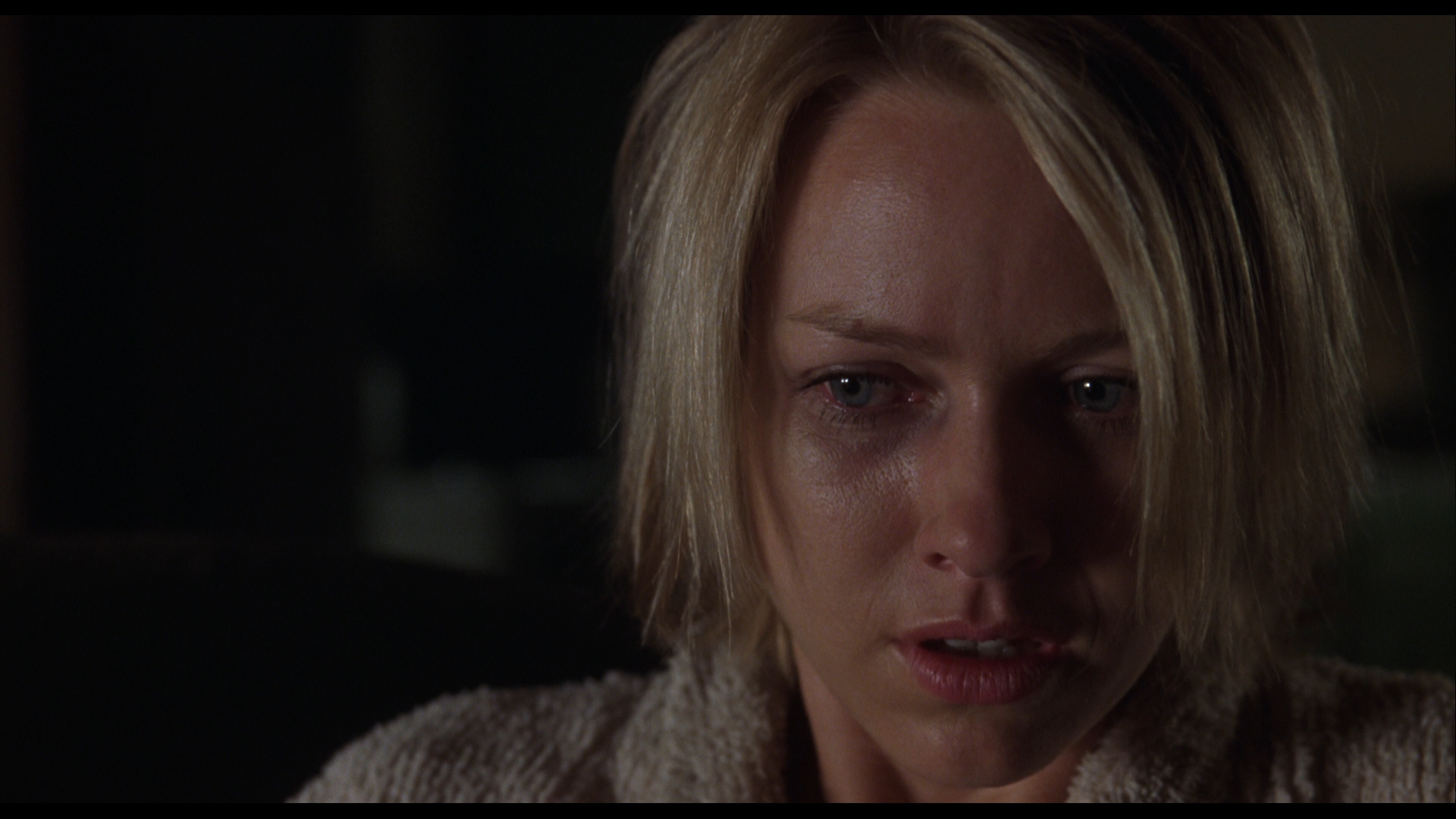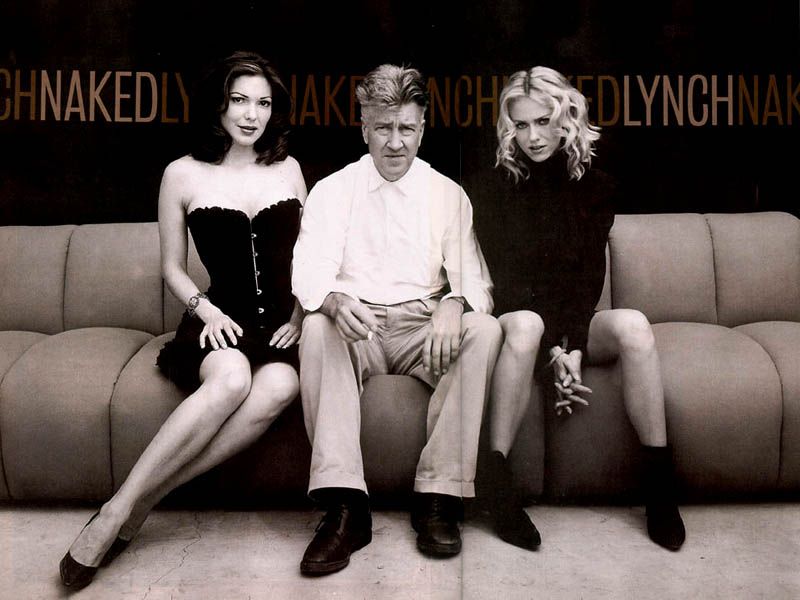I really didn't like Mulholland Drive when I saw it at its premiere at the NZ Film Festival in 2001/2002, and this is the first time I’ve been back to David Lynch's film.
So I’m coming at this (very literal) review as someone who’s seen it before, has utterly vague memories of how the story plays out (there’s a blue box and a crazy director and a Lost Highway ‘reality’ twist in it), and who remembers the audience (and me) being profoundly alienated by the movie after it finished. What you're about to read are my real-time reactions, as I re-watch the film.
The movie starts with an upbeat highly stylized green-screen dance number. I have absolutely no memory of this. And no idea about how it thematically relates to the rest of the story. I do notice however, that for some reason it starts to become disturbing after about a minute – but I have no idea why (there are some discordant notes in the music, and possibly some subliminal images in the background, and – possibly – some disturbing facial expressions or body language from some of the dancers).
When we cut into the movie proper, I expect to see Naomi Watts (newly arrived to LA) leaving LAX in the middle of the day with an elderly couple: that’s my memory of how the movie starts.
Instead, we cut to the middle of the night and a violent noir based car crash and hunt for a missing person. Who is the beautiful woman I remember first appearing in the middle of the film. This stuff is perfectly executed: there’s a Lynchian off-centre quality to it, but it’s tight, makes me car about the as-yet-unnamed character, sets up a world surrounding her, and even has a lovely ending (showing how she plausibly sneaks into an empty house).
And from there we cut to something I also remembered happening in the middle of the film – so I completely throw out my assumptions that I have any idea what’s going to happen next – another perfectly executed sequence in which a man sitting in a diner describes a nightmare he had, and then we see him experience it in real life.
There are lots of nice techniques used in this ‘real nightmare’ sequence: camera angles gradually rising above the head of the man having the nightmare (to put him in a weak, vulnerable position); a threatening hum growing louder in the score; dialogue seeming to cut out as the panic in the scene increases (very reminiscent of the arrival of David Bowie in Fire Walk with Me).
At the moment, none of these three things seem to have anything to do with each other. My working hypothesis, then, is that Mulholland Drive is a movie of very cool, slightly-connected short films.
And now, 18 minutes into the film, Naomi Watts (who plays what I remember to be the main character) shows up.
Over the course of the next 50 minutes, the movie continues to present what appears to be great self-contained short films (a really funny casting meeting between a film director and two Mafioso; a series of pratfalls involving a hitman with really bad luck) – but we keep cutting back to Naomi Watts (Betsie), who is now interacting with the beautiful car-crash woman (Rita). The tone of their scenes and plot details that emerge establish Mulholland Drive fairly firmly as a noir (a bag full of thousands of dollars; a beautiful woman with amnesia; the sense that powerful forces are hunting for them).

However, there’s another tone that’s being layered in as well: horror. It comes from the scenes that surround the Betsie-Rita plot; from music cues; from events that happen to Betsie (a possibly psychic woman delivers a dire warning). In the cleverest use of subtext to deliver horror, Betsie and Rita have a conversation in the same diner where the man from the start of the movie relayed his nightmare. Without using any overt camera angles or musical cues, Lynch is effortlessly able to create tension – and the dread that the mysterious figure from the man’s nightmare will suddenly appear here.
There’s also the subtlest (and, then, increasingly slightly-less-subtle) hints of romance flickering to life between Betsie and Rita. I remember this becomes more important as the film goes on.
All the while, though, the film is knitting together the ‘short films’ into an over-arching plot: the unlucky hitman is (a) possibly working for the two Mafioso and (b) searching for Rita. The film director (Adam) has been forced to cast a woman in his film – a woman who looks a lot like Betsie. If he does cast Betsie, however, that will be the wrong woman – and very bad things will happen.
It’s the anticipation of that that’s keeping me interested in the film at the moment. The rest of it is good: coherent, funny, idiosyncratic and sexy – but I want to see how the Adam and Betsie sides of the plot collide.
And all the while, I’m remembering that at some point in the future there’s going to be a scene in a nightclub, and that the consequences of that scene will totally shift the tone and storyline of the film. I’m fascinated to know when that’ll happen, how much story will be left afterward (an epilogue? an entire act?), and whether I’ll be invested in that ‘reality twist’. I can certainly remember feeling betrayed or alienated by it last time I saw it.
Anyway, back in the moment: the film spends the next 20 minutes directly addressing all of the questions I’m interested in, and in a really fascinating and oblique way. There’s a audition, yes – but it’s both a fake-out (in that it’s revealed to be a different movie than Adam’s) and filled with really interesting subtext: about exploitation in Hollywood, about the different ways performance can be used to affect the emotional presentation of a script, and it also demonstrates that Betty actually has talent – something the film to date has been a little shy about dealing with, preferring to show her as a naïve country girl who might be a big shot in her hometown but who is out of her depth in LA.
(Speaking of which, Mulholland Drive also shows us a lot of different economic and geographic facets of LA. It has a real sense of place and feels complex.)
The Adam and Betty meeting also doesn’t go how I expected (instead of a sitcom misunderstanding there’s a complete capitulation), but it gives us something better: an attraction or connection between Adam and Betty that I want to see more of.
And from there, the movie hits its strongest streak of sustained narrative: following Betty and Rita through an investigation, a break-in, a discovery, sex and love, returned memories, a surreal performance, a disappearance, an amazing performance of Roy Orbison’s Crying (which really feels like we’re saying goodbye to our characters and the status quo – seriously, this is a transcendent moment in the film) and finally the truth about the blue box.
It’s during this streak that a bunch of overt optical effects start getting used: multiple images of Betty and Rita layered over each other while they panic; some odd lens flare en route to the performance; an almost Evil Dead camera push-in outside the mysterious Silencio club.
And then the twist.
I actually wish I was struggling to interpret what was going on: is this the afterlife? A flashback? Did Betty never really exist at all? Was the first 110 minutes of the film just a dream?
But at the moment, eight minutes in to the revelation of what’s on the other side of the blue box, the interpretation seems pretty obvious: what we’ve just watch is an idealized version of Diane’s love and life, and it’s either a dream or the final moments before she shoots herself.
However, rather than feeling betrayed by that (as I now remember I did during my first viewing), I can make the argument that the structure of the film so far has prepared me for this. I’ve spent a lot of time feeling like I was watching a series of short films. This section is also like a short film, but with a massive switch in tone: from horror-noir with a dash of romance to a piece about depression with a dash of the craziness and jealousy of a failed relationship.
(And to be fair, the film does lay in a lot of hints throughout the first hour and a half: among others, Betty describes the apartment she’s staying in as a “dream place”; when she arrives in LA – and there’s a lot of cute dialogue like that.)
The biggest problem with this “It was all a dream” structure is that the storylines I was invested in and wanted to see closure in won’t happen. I’ll never find out how Adam resolves his problems with the Mafia (although I can assume that everything ended happily after he chose ‘the right girl’ for his film). The unlucky hitman may not have a place in this new reality, so he’s a tangent. The man with the nightmare either doesn’t relate to the film or becomes a massive commentary and early hint about the nature of the film. This is a variant of what I call the ‘John Locke’ problem (from Lost): we think we’re following one character around, and then it turns out we’re actually following another.
Now, as the film continues, and shows me the close-to-the-starting shot of a car driving driving up a hill at night. What is Mulholland Drive trying to do now? Loop us back to the start of the film but with Betty/Diane in the car instead of Rita/Camilla?
No. It’s giving us a magical experience of Diane and Rita/Camilla apparently in love and going to a party hosted by Adam, … and then taking it all away from us in a wave of jealousy, loss, insecurity, not fitting in, barely repressed anger.
And then what the fuck?
The film cuts away from the party – an incredible hard-cut on Diane’s utter anger and the first frame of an emotional clusterfuck – into … another reality? That’s my first thought: that now we’re in the ‘real world’, one where Betty/Diane has become (or was all along) a hooker we saw incidentally in a previous scene, hanging out with the hitman.
And this hard-cut has taken us into the diner where the nightmare took place again – instantly raising a sensation of impending dread …
… this is, actually, pretty great stuff …
But it’s not another reality – it’s a flash-forward, to Diane putting a hit on Camilla.
Which gives me everything I need to (roughly) figure out the film’s true structure:
- When we first enter/wake into this ugly new reality (after opening the blue box), that’s at the end of the timeline
- Dianne and Camilla are friends
- Camilla leaves Dianne
- Dianne discovers Camilla is dating Adam, and that those two are getting married
- Dianne orders the hit
- Dianne, depressed (this is where we first switch into her reality)
- The hit happens (perhaps it’s the failed murder attempt at the beginning?)
- Dianne kills herself after being haunted.
I was going to rewatch the last 20 minutes of the film, to confirm this, but while I was putting the finishing touches on this post, Film Critic Hulk did it for me, in a great piece from someone who’s watching the film 11 times:
This is a insightful critique that confirms a lot of what I thought, but it's also given me a lot more to think about (including the role of the Cowboy). To my surprise, I now think I'll be rewatching this film again.
.gif)







